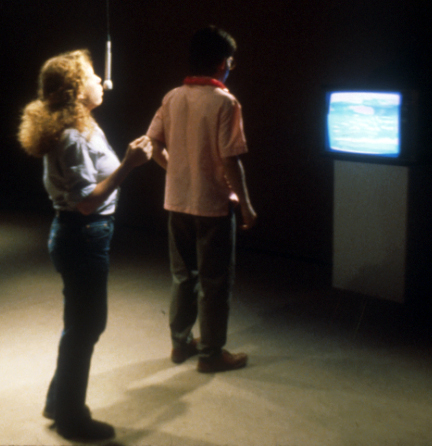
May 1982 - Artist's Statement – Vibeke Sorensen
Installation at the Squires Gallery, Virginia Polytechnic Institute
Does the Right Hand Know What the Left Hand is Doing?
Our hands are our interface to our physical environment. They provide us with information about all aspects of our lives and help us to communicate with those around us. Just as each hand has its skills and special purposes, so do the corresponding halves of the brain. It is thought that the right side is more visual and intuitive, and that the left side is more verbal and analytical. This split symbolizes societal attitudes towards art and science. Traditionally, the two areas were irreconcilable because misunderstandings and misinformation have clouded most hopes for collaboration and interaction.
Today, with “user-friendly” machines in a technological revolution, the two fields are merging faster than ever. Many tool makers (scientists and engineers) are finding that they need data makers (artists and designers) to justify the tools in terms of humanism. Artists are fascinated by the potentials of the phosphorescent babysitters that helped to raise them. Though apprehension still exists on both sides, artists and scientists are finding that they not only speak the same language, but they have similar concerns for the future of electronic and computer technology. This crossover, much like the crossover of nerve endings in the brain, is contributing to the development of a new artform, computer art.
In this installation, the Gallery's two rooms are divided according to passive and active uses of electronic media. In the small room, prints on walls reflect the tapes being shown on the video monitors. These tapes were produced between 1974 and 1982 using a wide range of television and computer technology including DEC computers, Moog and Rutt/Etra audio and video synthesizers, Grass Valley Switchers, New England Digital Corporation's Synclavier, Eventide Digital Harmonizers, and Quantel and Vital digital frame buffers. In the Large room, I have included a live interactive system which allows action in front of a camera to be combined with video feedback through an Electronic Associates of Berkeley video synthesizer/colorizer. The images are “voltage-controlled” by a microphone in the Gallery so that the images respond to sounds made by people in the space. The feedback symbolizes a growing awareness on the part of both artists and engineers as they see themselves and each other ina creative technological landscape. It is an effort to bridge the gap between art and science by allowing visitors in the Gallery to observe art and participate in the making of it.
It is hope that this exhibit will stimulate further collaboration between artists and scientists. The creative process is common to both, for a leap of imagination is required in the invention of both new tools and new images. If the right hand seeks out the left hand, the two can embrace and rise to new heights of creative and technological invention.
